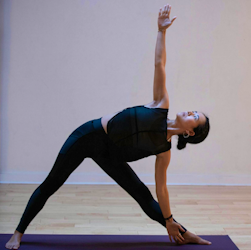Continuing Education || Applied Anatomy || Muscular-Skeletal Anatomy For Legs, Hips & Spine: Applied to Standing, Twist, & Hip Opening

Led by: Tara Glazier
From March 22, 2024 at 2:00 pm until March 24, 2024 at 4:00 pm at Dumbo
Schedule:
March 22nd, Friday — 2-4pm, 5-9pm
March 23rd, Saturday — 1-4:45pm
March 24th, Sunday — 9-11:15am, 12-4pm
Anatomy specific to yoga and yoga asana is a unique way of exploring anatomical principles. While we do learn insertion and attachment points, function, and how the muscle is stretched, it is also very important to understand what is “balanced action” and how that applies to both the primary mover and the antagonist. Because we use “isometric” force in yoga asana, it is more complex than simply contracting and releasing the muscle fibers. Isometric force, like a simultaneous push/ pull action is what keeps each side of the body toned to create balance. Working the muscles the way you would at the gym on machines is very different than how we use our own body weight, alignment of the skeleton, and isometric action, in yoga asana. And to that end, the study of anatomy for yoga is specific for asana which are holistically executed as opposed to one muscle at a time.
The Abhaya Method focuses on first skeletal anatomy to find stacking of joint support and anatomical “neutral”. From here the body will feel less stress and can take more weight and complex postures. We build second to muscular joint support and muscular tone in a balanced three dimensional way.
Lastly, we create mobility throughout the fascial fabric of the body to open for optimal stability and freedom within the structure.
Learn specifically:Skeletal anatomy of the hip structure, hip joints, lower body and spine
Muscular anatomy of how to support the joints of knee, hip
How to free up the hips and bone/ muscle/ fascial components of the entire “familial structure” of the hip/low back
How to free up the spine and the fascial bands around the spine
Simple queuing and instruction to guide our students into greater freedom of movement
Prerequisite : 200 Hour YTT required
March 22nd, Friday — 2-4pm, 5-9pm
March 23rd, Saturday — 1-4:45pm
March 24th, Sunday — 9-11:15am, 12-4pm
Anatomy specific to yoga and yoga asana is a unique way of exploring anatomical principles. While we do learn insertion and attachment points, function, and how the muscle is stretched, it is also very important to understand what is “balanced action” and how that applies to both the primary mover and the antagonist. Because we use “isometric” force in yoga asana, it is more complex than simply contracting and releasing the muscle fibers. Isometric force, like a simultaneous push/ pull action is what keeps each side of the body toned to create balance. Working the muscles the way you would at the gym on machines is very different than how we use our own body weight, alignment of the skeleton, and isometric action, in yoga asana. And to that end, the study of anatomy for yoga is specific for asana which are holistically executed as opposed to one muscle at a time.
The Abhaya Method focuses on first skeletal anatomy to find stacking of joint support and anatomical “neutral”. From here the body will feel less stress and can take more weight and complex postures. We build second to muscular joint support and muscular tone in a balanced three dimensional way.
Lastly, we create mobility throughout the fascial fabric of the body to open for optimal stability and freedom within the structure.
Learn specifically:
Prerequisite : 200 Hour YTT required